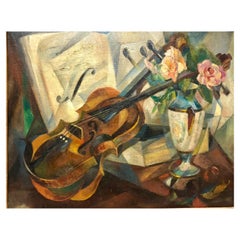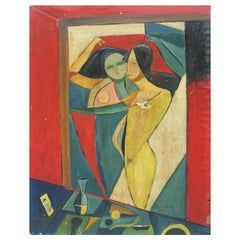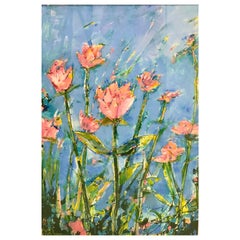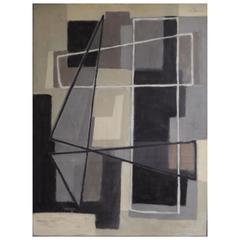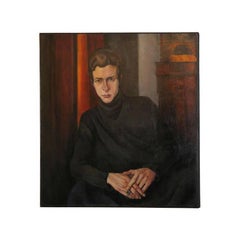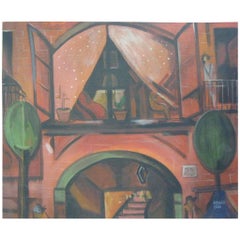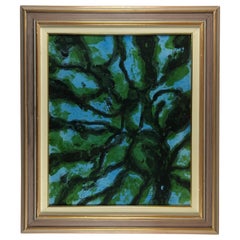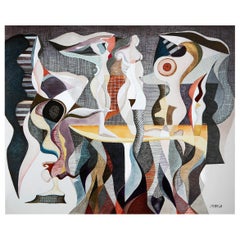Thomas Gallery Ltd Contemporary Art
to
2
21
19
2
Height
to
Width
to
11
4
19
2
3
14
1
5
1
3
5
3
3
2
1
17
8
4
4
3
21
21
21
1
1
1
1
1
Cubist Still Life "Violin" by Early Modernist, Agnes Weinrich, Signed Dated 1922
By Agnes Weinrich
Located in New York, NY
Still life painting (Violin, Flowers), Oil on canvas, by Agnes Weinrich, Signed and dated "22", Unframed: 20" x 16", Framed 27.5 x 23".
Agnes Weinrich (1873-1946) was an early female, American modernist artist at a time when there was little interest in Modern Art in the USA and when few women were artists. She was a ground breaker in modern art. The painting shown is an important example of her mature phase of her work.
A biography from Wiki-pedia follows:
Agnes Weinrich (1873–1946) was one of the first American artists to make works of art that were modernist, abstract, and influenced by the Cubist style. She was also an energetic and effective proponent of modernist art in America, joining with like-minded others to promote experimentation as an alternative to the generally conservative art of their time.
Early years[edit]
Agnes Weinrich was born in 1873 on a prosperous farm in south east Iowa. Both her father and mother were German immigrants and German was the language spoken at home. Following her mother's death in 1879 she was raised by her father, Christian Weinrich. In 1894, at the age of 59, he retired from farming and moved his household, including his three youngest children—Christian Jr. (24), Agnes (21), and Lena (17), to nearby Burlington, Iowa, where Agnes attended the Burlington Collegiate Institute from which she graduated in 1897.[1][2][3] Christian took Agnes and Lena with him on a trip to Germany in 1899 to reestablish links with their German relatives. When he returned home later that year, he left the two women in Berlin with some of these relatives, and when, soon after his return, he died, they inherited sufficient wealth to live independently for the rest of their lives.
Either before or during their trip to Germany Lena had decided to become a musician and while in Berlin studied piano at the Stern Conservatory. On her part, Agnes had determined to be an artist and began studies toward that end at the same time.[1][4] In 1904 the two returned from Berlin and settled for two years in Springfield, Illinois, where Lena taught piano in public schools and Agnes painted in a rented studio. At this time Lena changed her name to Helen. In 1905 they moved to Chicago where Agnes studied at the School of the Art Institute of Chicago under John Vanderpoel, Nellie Walker, and others.[1]
In 1909 Agnes and Helen returned to Berlin and traveled from there to Munich, where Agnes studied briefly under Julius Exter, and on to Rome, Florence, and Venice before returning to Chicago.[5] They traveled to Europe for the third, and last, time in 1913, spending a year in Paris. There, they made friends with American artists and musicians who had gathered there around the local art scene. Throughout this period, the work Agnes produced was skillful but unoriginal—drawings, etching, and paintings in the dominant academic and impressionist styles.[1]
On her return from Europe in 1914, she continued to study art, during the warm months of the year in Provincetown, Massachusetts,[1] where she was a member of the Provincetown Printers art colony in Massachusetts,[6] and during the colder ones in New York City. In Provincetown she attended classes at Charles Hawthorne's Cape Cod School of Art and in New York, the Art Students League.[1]
Drawing of an old woman by Agnes Weinrich, graphite on paper, 11.5 x 7.5 inches.
Hawthorne and other artists established the Provincetown Art Association in 1914 and held the first of many juried exhibitions the following year. Weinrich contributed nine pictures to this show, all of them representational and somewhat conservative in style.[1]
A pencil sketch made about 1915 shows a figure, probably one of the Portuguese women of Provincetown. Weinrich was a metculous draftsperson and this drawing is typical of the work she did in the academic style between 1914 and 1920. She also produced works more akin to the Impressionist favored by Hawthorne and many of his students. When in 1917 Weinrich showed paintings in a New York women's club, the MacDowell Club, the art critic for the Brooklyn Daily Eagle said they showed a "strong note of impressionism."[7]
Broken Fence by Agnes Weinrich, a white-line woodblock made on or before 1917; at left: the woodblock itself; at right: a print pulled from the woodblook.
In 1916 Weinrich joined a group of printmakers which had begun using the white-line technique pioneered by Provincetown artist B.J.O. Nordfelt. She and the others in the group, including Blanche Lazzell, Ethel Mars and Edna Boies Hopkins, worked together, exchanging ideas and solving problems.[1][8] A year later Weinrich showed one of her first white-line prints at an exhibition held by the Pennsylvania Academy of Fine Arts in Philadelphia.[9]
Broken Fence, in its two states—the print and the woodblock from which she made it—show Weinrich to be moving away from realistic presentation, towards a style, which, while neither abstract, nor Cubist, brings the viewer's attention to the flat surface plane of the work with its juxtaposed shapes and blocks of contrasting colors.
Cows Grazing in the Dunes near Provincetown by Agnes Weinrich, white-line woodcut, 10 x 10 1/2 inches
When in 1920 the informal white-line printmakers' group organized its own exhibition, Weinrich showed a dozen works, including one called Cows Grazing in the Dunes near Provincetown. This print shows greater tendency to abstraction than eitherBroken Fence or the prints made by other Provincetown artists of the time. The cows and dunes are recognizable but not presented realistically. The white lines serve to emphasize the blocks of muted colors which are the print's main pictorial elements. Weinrich uses the texture of the wood surface to call attention to the two-dimensional plane—the paper on which she made the print—in contrast with the implicit depth of foreground and background of cows, dunes, and sky. While the work is not Cubist, it has a proto-Cubist feel in a way that is similar to some of the more abstract paintings of Paul Cézanne.[10]
By 1919 or 1920, while still spending winters in Manhattan and summers on Cape Cod, the sisters came to consider Provincetown their formal place of residence.[1][11][12][13] By that time they had also met the painter, Karl Knaths. Like themselves a Midwesterner of German origin who had grown up in a household where German was spoken, he settled in Provincetown in 1919. Agnes and Knaths shared artistic leanings and mutually influenced each other's increasing use of abstraction in their work.[1][14]
The sisters and Knaths became close companions. In 1922 Knaths married Helen and moved into the house which the sisters had rented. He was then 31, Helen 46, and Agnes 49 years old. When, two years later, the three decided to become year-round residents of Provincetown, Agnes and Helen used a part of their inheritance to buy land and materials for constructing a house and outbuildings for the three of them to share. Knaths himself acquired disused structures nearby as sources of lumber and, having once been employed as a set building for a theater company, he was able to build their new home.[15]
Weinrich was somewhat in advance of Knaths in adopting a modernist style. She had seen avant-garde art while in Paris and met American artists who had begun to appreciate it. On her return to the United States she continued to discuss new theories and techniques with artists in New York and Provincetown, some of whom she had met in Paris. This loosely-knit group influenced one another as their individual styles evolved. In addition to Blance Lazzell, already mentioned, the group included Maude Squires, William Zorach, Oliver Chaffee, and Ambrose Webster. Some of them, including Lazzell and Flora Schofield had studied with influential modernists in Paris and most had read and discussed the influential Cubist and Futurist writings of Albert Gleizes and Gino Severini.[16][17]
Mature style[edit]
Woman with Flowers by Agnes Weinrich, circa 1920, oil on canvas, 34 x 30 1/4 inches, exhibited at the Provincetown Art Association exhibition of 1920, made available courtesy of the Association.
Two of Weinrich's paintings, both produced about 1920, mark the emergence of her mature style. The first, Woman With Flowers, is similar to one by the French artist, Jean Metzinger called Le goûter (Tea Time) (1911).[18]
Red Houses by Agnes Weinrich, circa 1921, oil on canvas on board, 24.25 x 25.5 inches; exhibited "Red Houses" at Fifth Annual Exhibition of the Society of Independent Artists.
Like much of Metzinger's work, Le goûter was discussed in books and journals of the time—including one called Cubism co-authored by Metzinger himself.[19] Because the group with which Weinrich associated read about and discussed avant-garde art in general and Cubism in particular, it is reasonably likely that Weinrich was familiar with Metzinger's work before she began her own.
The second painting, Red Houses, bears general similarity to landscapes by Cézanne and Braque. Both paintings are Cubist in style. However, with them Weinrich did not announce an abrupt conversion to Cubism, but rather marked a turning toward greater experimentation. In her later work she would not adopt a single style or stylistic tendency, but would produce both representative pictures and ones that were entirely abstract, always showing a strong sense of the two-dimensional plane of the picture's surface. After she made these two paintings neither her subject matter nor the media she used would dramatically change. She continued to employ subjects available to her in her Provincetown studio and the surrounding area to produce still lifes, village and pastoral scenes, portraits, and abstractions in oil on canvas and board; watercolor, pastel, crayon and graphite on paper; and woodblock prints.[20]
Possessing an outgoing and engaging personality and an active, vigorous approach to life, Weinrich promoted her own work while also helping Karl Knaths to develop relationships with potential patrons, gallery owners, and people responsible for organizing exhibitions. With him, she put herself in the forefront of an informal movement toward experimentation in American art. Since, because of her independent means, she was not constrained to make her living by selling art, she was free to use exhibitions and her many contacts with artists and collectors to advance appreciation and understanding of works which did not conform to the still-conservative norm of the 1920s and 1930s.[1][21][22]
Early in the 1920s, critics began to take notice of her work, recognizing her departure from the realism then prevailing in galleries and exhibitions. Paintings that she showed in 1922 drew the somewhat dry characterization of "individualistic.",[23] and in 1923 her work drew praise from a critic as "abstract, but at the same time not without emotion."[24]
In 1925 Weinrich became a founding member of the New York Society of Women Artists. Other Provincetown members included Blanche Lazzell, Ellen Ravenscroft, Lucy L'Engle, and Marguerite Zorach. The membership was limited to 30 painters and sculptors all of whom could participate in the group's exhibitions, each getting the same space.[23][25][26] The group provided a platform for their members to distinguish themselves from the genteel and traditionalist art that women artists were at that time expected to show[27] and, by the account of a few critics, it appears their exhibitions achieved this goal.[1][28][29][30]
In 1926 Weinrich joined with Knaths and other local artists in a rebellion against the "traditional" group that had dominated the Provincetown Art Association. For the next decade, 1927 through 1937, the association would mount two separate annual exhibitions, the one conservative in orientation and the other experimental, or, as it was said, radical.[31][32] Both Weinrich and Knaths participated on the jury that selected works for the first modernist exhibition.[11]
Still Life by Agnes Weinrich, circa 1926, oil on canvas, 17 x 22 inches. Permission to use granted by Christine M. McCarthy, Executive Director, Provincetown Art Association and Museum. The painting was the gift of Warren Cresswell.
Weinrich's painting, Still Life, made about 1926, may have been shown in the 1927 show. Representative of some aspects of her mature style, it is modernist but does not show Cubist influence. The objects pictured are entirely recognizable, but treated abstractly. Although fore- and background are distinguishable, the objects, as colored forms, make an interesting and visually satisfying surface design.
In 1930 Weinrich put together a group show for modernists at the GRD Gallery in New York. The occasion was the first time a group of Provincetown artists exhibited together in New York. For it she selected works by Knaths, Charles Demuth, Oliver Chaffee, Margarite and William Zorach, Jack Tworkov, Janice Biala, Niles Spencer, E. Ambrose Webster, and others.[1][23]
Later years[edit]
Weinrich turned 60 on July 16, 1933. Although she had led a full and productive life devoted to development of her own art and to the advancement of modernism in art, she did not cease to work toward both objectives. She continued to work in oil on canvas and board, pastel and crayon on paper, and woodblock printing. Her output continued to vary in subject matter and treatment. For example, Still Life with Leaves, circa 1930 (oil on canvas, 18 x 24 inches) contains panels of contrasting colors with outlining similar to Knaths's style. Movement in C Minor, circa 1932 (oil on board, 9 x 12 inches) is entirely abstract. It too relates to Knaths's work, both in treatment (again, outlined panels of contrasting colors) and in its apparent relationship to music, something in which Knaths was also interested. Fish Shacks...
Category
Early 20th Century American Modern Contemporary Art
Materials
Paint, Canvas
European Midcentury Cubist Painting 'Nude' by Koroly Glonczy, Hungary, 1957
By Koroly Glonczy
Located in New York, NY
Cubist Painting by Hungarian Painter, Koroly Glonczy.
Oil on cardboard.
References: Modern and contemporary art. European 20th century, Mid-Century Modern.
Category
Vintage 1950s Hungarian Modern Paintings
Materials
Paint
Painting of Flowers in the School of Matisse by James Antonie
By James Antonie, Henri Matisse
Located in New York, NY
Painting of flowers by James Antonie. Signed. Acrylic on paper.
The painting is filled with exuberant color, light, vitality and life
Framed in white wood with plexi-glass. Dim...
Category
21st Century and Contemporary American Modern Contemporary Art
Materials
Acrylic, Paper
Mid-Century "Ecole de Paris" Abstraction "Symphony in Grey" by Ferenc Varga 1957
Located in New York, NY
"Symphony in Grey" is an iconic oil on canvas, modern art painting by the Hungarian born artist, Ferenc Varga (Hungary, 1906-1989).
Varga left Hungary fo...
Category
Vintage 1950s French Modern Paintings
Materials
Canvas
Androgynous 'New Objectivity' Portrait by Hans Speidel
By Hans Speidel
Located in New York, NY
Oil on canvas. Painting by Hans Speidel, Berlin.
Speidel was among a group of painters known as the 'Neue Sachlichkeit' (New Objectivity). This betwee...
Category
Mid-20th Century German Mid-Century Modern Paintings
Painting, Oil, 'Street Scene' Signed Bela Kadar
By Bela Kadar
Located in New York, NY
Painting, Street Scene, Signed Bela Kadar, (Hungary 1877-1955), un-framed, oil on board.
Bela Kadar was born in Hungary in 1877. Amongst his early interests was mural painting. Like many of the artists of his day he was drawn to Paris and Berlin, and by 1910 he had visited both cities twice. In 1923, Kadar showed his paintings in Berlin at the invitation of Herwath Walden. Walden was an important figure in the German avant-garde, being the publisher of the journal Der Sturm which featured the works of Franz Marc, Paul Klee, Wassily Kandinsky, Marc Chagall and Oskar Kokoschka. During the group exhibition at Walden's gallery with other artist's of Der Sturm, Kadar met Katherine Dreier whose Societe Anonyme was instrumental in bringing the work of the European avant-garde to New York. With her help two major exhibitions of his work were planned for the Brooklyn Museum of Art, the second of which in September 1928 Kadar travelled from Europe to attend.
Bela Kadar incorporated themes of Hungarian...
Category
Vintage 1930s Hungarian Mid-Century Modern Paintings
Metaphysical Painting by Roger Hullaert, Belgium, 1932-1988
By Roger Hullaert
Located in New York, NY
Painting in oil Signed R. Hullaert.
Painted from an architectural perspective with a stairway leading into, the painting references a surrealist / metaphysical theme of accessing ...
Category
Mid-20th Century Belgian Modern Paintings
Portrait of an Elegant Woman, Signed Hugo Scheiber
By Hugó Scheiber
Located in New York, NY
Watercolor / painting signed Hugo Scheiber: Budapest (1873-1950).
Hugo Scheiber was born in Budapest in 1873. At the age of eight, he moved with his family from Budapest to Vienna. ...
Category
Mid-20th Century Hungarian Mid-Century Modern Paintings
Untitled Painting '2 Women Engaged in Dialogue' by Bela Kadar
By Bela Kadar
Located in New York, NY
Painting by Bela Kadar
Bela Kadar was born in Hungary in 1877. Amongst his early interests was mural painting. Like many of the artists of his day he was drawn to Paris and Berlin, and by 1910 he had visited both cities twice. In 1923, Kadar showed his paintings in Berlin at the invitation of Herwarth Walden. Walden was an important figure in the German avant-garde, being the publisher of the journal Der Sturm which featured the works of Franz Marc, Paul Klee, Wassily Kandinsky, Marc Chagall and Oskar Kokoschka. During the group exhibition at Walden's gallery with other artists of Der Sturm, Kadar met Katherine Dreier whose Société Anonyme was instrumental in bringing the work of the European avant-garde to New York. With her help two major exhibitions of his work were planned for the Brooklyn Museum of Art, the second of which in September 1928 Kadar travelled from Europe to attend.
Bela Kadar incorporated themes of Hungarian folklore...
Category
Vintage 1930s Hungarian Paintings
Untitled Nude with Still Life by Gabor
By Gabor
Located in New York, NY
Paintng by Gabor. Gabor was influenced by cubism and expressionism, fusing both together in dynamic intriguing compositions.
Category
Vintage 1930s Hungarian Paintings
Untitled 'Still Life with Cut Ribs' by Micheline Mevel-Roussel
By Micheline Mevel-Roussel
Located in New York, NY
Painting by Micheline Mevel-Roussel: France.
Category
20th Century French Modern Paintings
Materials
Paint
Untitled 'Portrait #2'
By Marcel Delmotte
Located in New York, NY
Marcel Delmotte: Belgium, 1901-1984
Marcel Delmotte est un artiste peintre belge et surréaliste wallon né en 1901 et mort en 1984.
Ce peintre aquarelliste, portraitiste...
Category
Vintage 1950s Belgian Paintings
Materials
Board
Portrait ‘Woman with Tilted Head’ Signed Hugo Scheiber
By Hugó Scheiber
Located in New York, NY
Painting, oil in cardboard, signed H Scheiber (Budapest 1873- 1950).
Hugo Scheiber was born in Budapest in 1873. At the age of eight, he moved with his family from Budapest to Vie...
Category
Early 20th Century Hungarian Modern Contemporary Art
Materials
Paint
Abstract Wood Collage by Felice Antonio Botta, Italy, 20th Century
By Felice Antonio Botta
Located in New York, NY
Abstract wood wall sculpture by Italian artist and designer, Felice Antonio Botta.
Botta was an early proponent of used 'poor materials' (recovered and found wood) for a movement ...
Category
Mid-20th Century Italian Mid-Century Modern Abstract Sculptures
Materials
Reclaimed Wood
Untitled ‘Intellectual’ by Hans Speidel
By Hans Speidel
Located in New York, NY
Oil on canvas, painting by Hans Speidel (1895-1976): Germany, Signed.
Speidel, opposed the Hitlerian racial laws, and was a proponent of the German mo...
Category
Mid-20th Century German Modern Paintings
Materials
Canvas
Untitled Landscape Painting by Gacy Ofkja
By Gacy Ofkja
Located in New York, NY
Landscape painting by Hungarian Painter, Ofkja.
Goache on cardboard.
References: Modern and Contemporary Art, Fauvism, Color Theory.
Category
Early 20th Century Hungarian Modern Paintings
Materials
Gouache
'New Objectivity' Drawing, Woman with Veil by Beeldens
By Beeldens
Located in New York, NY
Drawing by Beeldens, Belgium, circa 1935.
References: Modern and Contemporary Art, New Objectivity, Neue Sachlichkeit.
Category
Vintage 1930s Belgian Modern Drawings
Materials
Pencil, Paper
Two Geometric Abstraction Paintings by Jeff Hudson
Located in New York, NY
Two geometric abstraction paintings by Jeff Hudson. Signed Jeff Hudson, 2014. Available Individually.
Jeff Hudson's paintings come from his life experiences, and trust in the power and beauty of color harmonies and fragile structure to make a visual statement of pleasure for the mind and soul.
Hudson went to The School of the Museum of Fine Arts in Boston 1968-1973 where he studied all mediums and focused on large color field painting. He also had access to video equipment and made video Art. In 1974 he was hired along with Jane Hudson to start the Video Performance department at the Museum School and taught for 30 years and was always involved in fine art everyday. Hudson's works embraced the modern and Postmodern.
Jeff played in a Punk band The Rentals and a New Wave band Jeff and Jane Hudson. They played all the venues in NYC and Boston and released a number of records. (they have been re- released and are on ITunes.)
He directed music videos for Pat Metheny...
Category
21st Century and Contemporary American Modern Paintings
Untitled (Artists Studio) by Birtl
Located in New York, NY
Cubist Painting
Category
Vintage 1930s Hungarian Paintings
Materials
Board
Untitled (Portrait) by Floris Jespers
By Floris Jespers
Located in New York, NY
Painting by Floris Jespers. Jespers (1889–1965) was a Belgian Avant-garde painter.
After his graduation from the Antwerp Academy of Fine Arts, he hooked up with the po...
After his graduation from the Antwerp Academy of Fine Arts, he hooked up with the po...
Category
Vintage 1940s Belgian Paintings
Materials
Board
"La Regadera Volosa y Lluviosa" by Arturo Miranda Videgaray
By Arturo Miranda Videgaray
Located in New York, NY
Arturo Miranda Videgaray, Mexico, born 1963, since 2002 he has been the Chief of the Professional Studies of the National School of Visual Arts, UNAM, Mexico. In his work fantasy doe...
Category
Late 20th Century Mexican Paintings
Related Items
Original Abstract Painting Signed Olivier
Located in Miami, FL
A fine original abstract oil painting signed Olivier.
Hand-signed on the lower right.
Wonderfully decorative piece of art.
Offered in a custom oak frame.
Framed measurements: 27 1/...
Category
20th Century French Paintings
Materials
Paper, Wood
Maria Astadjov Modern Abstract Painting "The Island of Souls", 2019
By Maria Astadjov
Located in Montreal, QC
Modern abstract, mixed-media on White Aluminum painting; titled “The Island of Souls” by Maria Astadjov, a conceptual fine artist. Signed on front botto...
Category
2010s Canadian Modern Paintings
Materials
Aluminum
Henry Matisse's 'Poisson Chinois': Color Lithograph from the Cut Out Series
By Henri Matisse
Located in Barcelona, Barcelona
Embark on a visual journey with this stunning large framed color lithograph by Henry Matisse, extracted from his iconic series of cut outs, specifically the artwork "Poisson Chinois"...
Category
Vintage 1970s French Modern Paintings
Materials
Paper
H 40.56 in W 20.87 in D 1.38 in
Magnus Engstrom Signed Swedish California Artist Mid-Century Modern Oil Painting
By Magnus Engstrom 1
Located in Studio City, CA
A wonderful and quite colorful oil on canvas painting by Swedish-American California artist Magnus Engstrom (1936- ).
The painting features a futurist cityscape and is done in the neo-cubist abstract expressionist artistic painting style that Engstrom embraced.
The painting is signed and dated (1970) by Engstrom.
Would be a great addition to any Mid-Century Modern or California art painting collection...
Category
Vintage 1970s American Mid-Century Modern Paintings
Materials
Canvas, Wood, Paint
H 37 in W 37 in D 1.5 in
Charles Levier Bouquet of Flowers Oil Painting in the Manner of Bernard Buffet
By Charles Levier
Located in Miami, FL
A fine, framed oil on board/isorel painting by Charles Levier, signed.
This wonderful mid-century modern painting is a fine example of Levier's work and is in very good original co...
Category
20th Century American Mid-Century Modern Paintings
Materials
Paint, Masonite
H 29.5 in W 22.63 in D 2.5 in
Paris France Street Scene Oil on Canvas Painting, Signed Burnett
By Caroline Burnett
Located in Miami, FL
A beautiful oil on canvas painting of a street scene in Paris, France. This painting perfectly depicts life in the "City of Lights" with its restaurants, busy streets, cafes and wond...
Category
20th Century French Paintings
Materials
Canvas, Paint
Midcentury Abstract Painting
Located in Atlanta, GA
Midcentury abstract painting, American, circa 1960s. This painting is signed "Seskis". We have been unable to research their work.
Category
Vintage 1960s American Mid-Century Modern Paintings
Materials
Canvas, Wood
Original Bernard Damiano Mid-Century Painting Nudes
By Bernard Damiano
Located in Miami, FL
Original expressionist painting by Bernardo Damiano (also known as Bernard Damiano).
He was an Italian expressionist painter and sculptor born on January 10, 1926 in Coni
(Piemonte), Italy and died in Nice, France on June 24, 2000. His classical art formation was at the Academia Albertina in Turino, Italy.
His works are numerous and well known. It is precisely during the 1970s that Bernard Damiano's painting is said to have moved away from a relationship with Jean Dubuffet, the Art brut or the Cobra movement, in "a nervous touch and a triturated paste" to draw his style from the rest of Expressionism. This proposal is however stated with reserve: like the Spanish Eduardo Pisano...
Category
20th Century French Mid-Century Modern Paintings
Materials
Paint, Paper
Pal Fried Nude Portrait Oil on Canvas
By Pal Fried
Located in San Diego, CA
Nude portrait oil on canvas by Hungarian/American artist Pal Fried. Excellent overall condition in period frame with a light vertical scratch line running along the lower middle as s...
Category
Mid-20th Century American Art Deco Paintings
Mid Century Abstract Texture Painting
Located in Countryside, IL
Mid century abstract texture painting
This painting measures: 48 wide x 0.3 deep x 36 inches high
Great vintage condition
We take our photos...
Category
Vintage 1970s American Mid-Century Modern Paintings
Materials
Canvas, Paint
Dorothy Sklar Cubist Charcoal Painting
By Dorothy Sklar
Located in San Diego, CA
Rare cubist charcoal painting by Dorothy Sklar. Framed. Most likely dating to the 1930s or early 1940s.
Dimensions: 31" x 22.25" frame
22.25" x 14 ...
Category
Mid-20th Century American Mid-Century Modern Paintings
Modern Nude by Kessler
Located in North Miami, FL
Large modern nude painting by Larry Kessler. Has beautiful texture and brush mark. Signed LK and dated 03.
Category
Early 2000s American Modern Contemporary Art
Materials
Canvas, Paint
